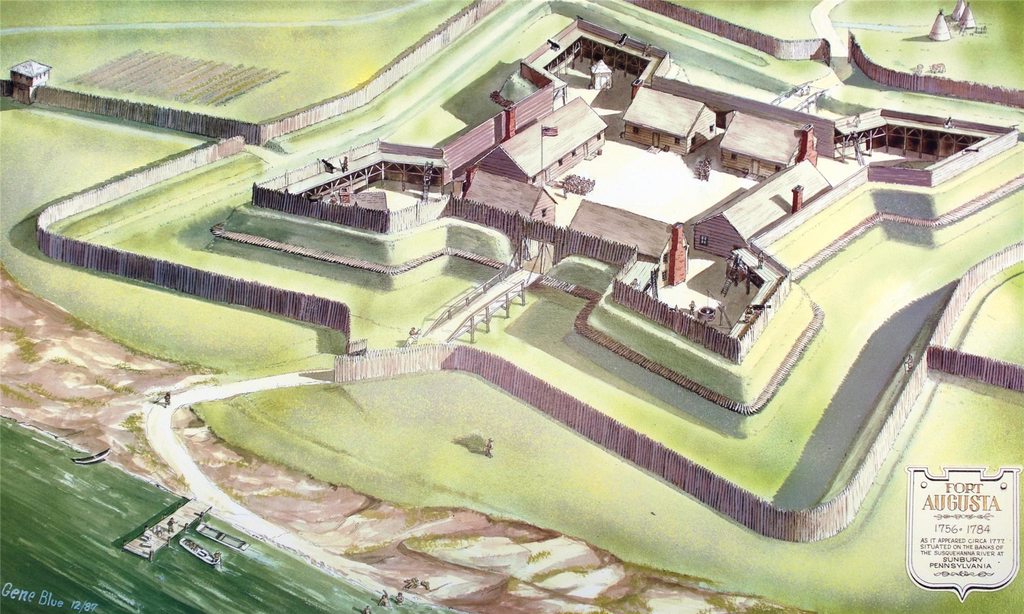Fort Augusta & Hunter House

Fort Augusta
Fort Augusta was Pennsylvania’s stronghold in the upper Susquehanna Valley, from the days of the French and Indian War to the close of the American Revolution. This site, now within the limits of the City of Sunbury, is an area which the Native Americans called “Shamokin.” First constructed as part of the British defense against the raids of the French and Indians from the upper Allegheny region, it was later used as an American fortress to aid in the protection of the settlers of the upper Susquehanna from the Indian allies of Britain.
Several important wilderness travel ways met near Fort Augusta. The river and its branches made canoe travel easy to the north, west, and south. From the headwaters of the West Branch near Emporium there was a portage of only twenty miles to the headwaters of the Allegheny River near Port Allegheny, or Canoe Place. A network of trails led in all directions. The Shamokin Trail, The Iroquois Warrior’s Trail, and the Kittanning Trail were alternate routes by which destruction might come upon the Pennsylvania frontier settlements. Fort Augusta was in key position for both defense and attack.
Colonel William Clapham, with a regiment of 400 men, pushed on to Shamokin in July 1756, and began to erect Fort Augusta, the largest of Pennsylvania’s provincial forts. By the time winter came, the fort was in condition to resist attack, even though its additional fortifications were not completed until the following year, under the direction of Colonel James Burd. Fort Augusta, built of logs which were upright in that part facing the river, and lengthwise in the rear, was about 200 feet square. The main wall of the fort was faced or “revetted” to about half its height by a dry ditch or moat. A triangular bastion in each corner permitted a crossfire that covered the entire extent of the wall. The main structure of the fort enclosed officers’ and soldiers’ quarters, a powder magazine, and a well, the last two of which are still preserved. Further protected by an outer stockade, the fort was flanked by four blockhouses, two on each side. The blockhouses were in turn connected by a stockade, forming a “covered way” to the river. The fort had sixteen cannons mounted, two of which are still preserved in the museum at the site.
Fort Augusta was never forced to endure a siege. Its strength and position were such that attack was discouraged. By its very existence it limited the effectiveness of the French raids and threatened French power in northwestern Pennsylvania. It held the Susquehanna Valley for Britain.
This allowed peaceful development of the territory around Fort Augusta to begin. The Proprietors made the Purchase of 1768 from the Indians and surveyed their Manor of Pomfret near Fort Augusta. Land was given to officers of Bouquet’s expedition of 1764 against the Ohio Indians as a reward for their services. In 1772 Northumberland County was formed, and Sunbury was laid out near Fort Augusta as the county seat. The first county courts met at the fort, and the powder magazine was used as the first jail.
During the Revolutionary War, Fort Augusta was the military headquarters of the American forces in the upper Susquehanna Valley. The activities of the Northumberland County Militia, the sending of troops to serve in Washington’s army, and the support and protection of smaller posts throughout the valley were all directed from the fort, where Colonel Samuel Hunter, the County Lieutenant of Northumberland County, resided.
Fort Augusta gradually deteriorated after the Revolutionary War. Colonel Samuel Hunter continued to reside in the Commandant’s Quarters, which had become his property. His descendants continued to live there until 1848 when the log house burned. The present Hunter House was completed in 1852 by the Colonel’s grandson, Captain Samuel Hunter.
In 1930 the Commonwealth of Pennsylvania purchased the land on which the well and powder magazine are located and, in 1931, acquired the larger tract, which included the Hunter House. Together they form the Fort Augusta property, which is now owned by and used as the headquarters of the Northumberland County Historical Society, Inc.
The Hunter House Museum
The museum at the Hunter House features a permanent exhibit of archaeological material recovered on the site during digs in 1937-1938, 1978-1979, and 1981. There are many items recovered from the Moravian Blacksmith Shop of 1743, Native American artifacts, as well as Fort Augusta. The exhibit also features a mural which depicts the construction of the fort, and items which represent fort life.
Timeline:
- 1756 – Fort Augusta erected by Colonel William Clapham.
- 1764 – Land given to officers of Bouquet’s expedition as a reward for their services.
- 1768 – Proprietors made the Purchase of 1768 from the Indians and surveyed their Manor of Pomfret near Fort Augusta.
- 1772 – Northumberland County formed and Sunbury laid out near Fort Augusta as the County Seat.
- 1848 – Log commandant’s quarters burned. Present Hunter House built by descendant of Colonel Samuel Hunter.
- 1930 – Commonwealth of Pennsylvania purchased the land on which the well and magazine are located.
- 1989 – Hunter House refurbished and turned over to NCHS as its headquarters
